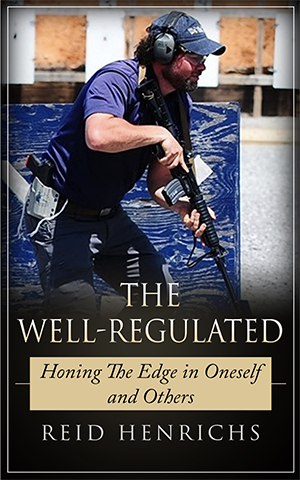The Well-Regulated: Honing the Edge in Oneself and Others
 By Reid Henrichs
By Reid Henrichs
Independently published (Feb. 2023)
279 pages, paperback, $22.99; eBook $19.99
ISBN-13: 979-8377419822
Reviewed by Gila Hayes
Last month, I read The Well Regulated by Network affiliated instructor Reid Henrichs. The way it blends American history with commentary and advice for students of shooting reminded me of Jeff Cooper’s Gargantuan Gunsite Gossip. The over 50 short chapters, returned often to the importance of fundamentals. Today’s lexicon has forgotten that “regulated” once indicated readiness, competence and skill.
Henrichs strongly advocates training until operating your pistol or rifle requires no conscious thought, reserving brain power for decision making. He repeats that advice in a variety of ways throughout the book. Invest in training to “learn shooting fundamentals, muzzle positions, firing solutions for a variety of distances and targets, as well as mental conditioning for preparation for violence,” he writes. You’ll learn more from classes that distill essential skills to limited numbers of time-proven techniques, he writes, observing that less is more. Focus on successful repetitions, instead of exposure to dozens of different drills, he recommends.
A lot of students want to skip entry level, basic instruction. Jumping ahead is a “major mistake that impedes development,” Henrichs warns. Another temptation is blaming poor marksmanship on equipment, he writes, “Never waver in your desire to get better but understand that nothing that you buy will help you shoot or develop better. Hard work, correct repetition, and guidance from knowledgeable teachers are all necessary.” He goes on to address choosing rifles and pistols, ammunition selection, and choices of after-market add-ons.
After exploring the role of the short-barreled revolver, Henrichs lauds old-style charging handles on AR-15s. The over-sized latch currently popular for the ability to operate it faster and with the support hand can inadvertently catch on other gear, taking the rifle out of battery. Unless justified by a scope that limits access to the charging handle, spend the money on improving your skills, he urges. Likewise, he criticizes the American obsession with hyper accurate rifles. Spend the money to train and practice, he suggests. “One’s skill coupled with willpower and focus will decide the outcome of the fight. The shooter matters far more than what he uses to shoot. Proficiency matters much more than equipment.”
Henrichs prioritizes factors he believes are most important to “prevailing during combat.” Proper gun handling is first, followed by firearm safety, and proficient marksmanship. Efficient movement – the hallmark of good technique – is more important than speed, he writes. Dead last in his prioritization are designer ammo and gadgets, although Henrichs gives the nod to options like white light, a rugged sling, and a sturdy optic.
Discussing iron sights and optics, he explains that despite using rifle optics, he always includes iron sight use in practice. Unless you routinely drill with iron sights, he warns, “do not expect to remember it under conditions of interpersonal combat.” A later chapter recommends zeroing the optic and the iron sights independently, due to refraction through the optic’s glass. The optic may be shattered or occluded, so best to plan to remove it and aim with iron sights, and as a result, he recommends quick detach mounts for emergency use. Observing that “there is no free lunch,” a later chapter also reviews pros and cons for fixed and variable power scopes and red dots.
In a chapter about the value of force-on-force scenario training Henrichs explains the importance of experience making “decisions while in an environment that simulates…daily lives, or mission parameters.” Scenarios must be safe and realistic, without no-win “gotcha” situations. Building student confidence is the goal and setting up people for failure is an all-too-easy possibility against which great care must be taken.
A later chapter addresses the effect of adrenaline and the role of psychological stress in causing an adrenaline dump, writing, “The more prepared you are, and the more you are exposed to stressful conditions, the less severe or debilitating the dump is.” Skills practiced to the level of subconscious competence remain available in the adrenalized state, Henrichs writes, explaining that “adrenaline does not affect the subconscious mind...If you train to the subconscious competence level of proficiency, action is reflexive rather than reactive. This does not mean that adrenaline will not affect someone after the fact…But what it does mean is that adrenaline has little to no effect on one’s proficiency, in terms of marksmanship or tactics if a person is trained to that level.”
Henrichs writes an interesting chapter comparing the events leading up to the American Revolution, when Britain sent armed forces to Boston to crush the fights between the loyal Tories and American patriots. The British forces set out to confiscate guns from the revolutionaries’ militia groups, in the name of “safety, security, and emergency crisis” the same rationale presented by government today. The militiamen were ready, but Henrichs fears that modern armed citizens don’t have the skills needed if thrust into a parallel fight today. “Instead of buying guns, more ammo, and more stuff, people need knowledge, sequenced training, sound methodology, and tactical maturity to win. Why? Because everything is at stake,” he warns.
There’s a lot of truth in the adage “freedom isn’t free.” In our relatively peaceful lives, it is all too easy to fail to develop and maintain fighting skills. I liked the way The Well Regulated blended American history about the fight for freedom with prioritization and lessons about shooting.
